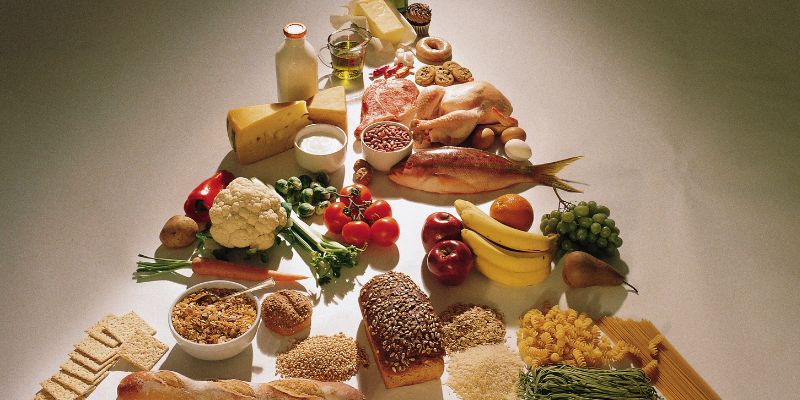From Pyramid to Plate: Why Was the Crumbling, Confusing Food Pyramid Replaced?
For years, the Food Pyramid represented sensible dietary rules. However, it baffled many people. It's layers and hazy serving sizes sometimes confuse those trying to follow it. Critics pointed out that it lacked current nutritional science and was outdated. The Department of Agriculture in the U.S. launched the MyPlate concept in 2011 to help with this.
This change made good eating simpler, more understandable, and easy to follow. The fresh plate design shows clarity and balance. With practical recommendations, it stresses food groups and portion sizes. Let's explore the reasons for this change and discuss the implications for your health.

The Origins and Decline of the Food Pyramid
The USDA presented the Food Pyramid in 1992 to help Americans choose better diets. It graphically arranged dietary categories in a triangle. It represents grains; the bottom layer urged heavy carbohydrate intake, while fats and oils were assigned to the little apex. It emphasizes low-fat diets, and this design captured the nutritional research of the day. Though at first appealing, the pyramid quickly drew criticism. Experts pointed out that it is too focused on carbohydrates, which fuels diabetes and obesity increase. Groups of both beneficial and bad fats confused people.
Moreover, the pyramid's serving size suggestions were nebulous and unrelated to actual cuisine. For instance, the number of plates or cups a serving equaled was not apparent. The Food Pyramid's recommendations grew progressively out of the current as nutrition research developed. Critics demanded a contemporary method addressing portion management and nutrient balance. Early in the new millennium, a replacement was needed. That helped to open the path for MyPlate's debut.
Why the Food Pyramid Was Replaced?
The Food Pyramid's main weakness was its framework. Its tiered architecture was complex and challenging to replicate in regular meals. Following the pyramid's direction, people battled to balance their plates. The pyramid also lacked a definition of nutritional priorities and portion sizes. Growing rates of obesity and lifestyle problems underlined the pyramid's shortcomings even more.
Health professionals said the pyramid neglected the complexity of contemporary diets. The pyramid, for instance, lacked a distinction between good and bad fats or whole and processed grains. It also omitted cultural eating customs and dietary variety. Its one-size-fits-all approach attracted another critique. The pyramid ignored personal demands such as age, degree of activity, or medical issues. The USDA created MyPlate to help handle these problems. The new concept sought to match revised nutrition science and simplify good eating.
What Is MyPlate?
MyPlate is a graphic aid introduced in 2011 to replace the Food Pyramid. Its architecture is simple: a small circle for dairy, a plate split into four portions for fruits, vegetables, grains, and meats. This arrangement clearly shows how to organize food components across each meal. One of MyPlate's strongest suits is its simplicity. For instance, half the plate is devoted to fruits and vegetables, stressing their value.
It emphasizes balance; grains and proteins fill the other half. The approach also encourages low-fat dairy, lean meats, and nutritious grains. More practically than the pyramid is my plate. It provides specific direction for creating meals, not only abstract layers. Its adaptability to many cuisines and dietary restrictions also stems from its versatility. MyPlate encourages people to make better daily decisions by stressing variety and portion sizes.
Key Differences Between the Food Pyramid and MyPlate
The transfer from the Food Pyramid to MyPlate produced notable changes in offering nutritional advice. The main distinctions are these:
- Visual Simplicity: Meals were difficult to link to the triangular form of the Food Pyramid. The design of MyPlate is simple and instructive.
- Porton Focus: MyPlate stresses portion amounts for every food group, helping one see well-balanced meals.
- Prioritization of Foods: Fruits and vegetables, which form half of My Plate, come first. Grain placement on the pyramid at the base encouraged a high carbohydrate consumption.
- Updated Science: MyPlate supports full grains and healthy fats, including modern nutrition science. The pyramid was not subtle.
- Flexibility: MyPlate may be customized to fit many ethnic and nutritional requirements, unlike the stiff pyramid.
These adaptations make MyPlate more useful for meeting today's dietary demands.
Benefits of MyPlate for Healthy Eating
The simple design of MyPlate has various advantages for encouraging good eating habits. That is why it works:
- Easy to Understand: The reasonable layout of the plate makes balanced meal planning easy.
- Encourages Variety: MyPlate stresses all food categories, therefore lowering the possibility of nutrient shortages.
- Focus on Portion Sizes: Clear divisions on the plate improve weight control by helping to control portions.
- Promotes Nutrient-Dense Foods: Reducing the risk of chronic diseases, MyPlate promotes nutritious grains, lean proteins, and fresh vegetables.
- Flexibility: Among the several diets the model can handle are vegetarian, gluten-free, and cultural cuisines.
These advantages make MyPlate necessary for changing food patterns and public health.

How to Use MyPlate Daily?
Including "MyPlate" in everyday meals is simple. Imagine first your plate split in half. Vegetables and fruits should account for half of it. Grains and proteins can comprise the other half. Toss some dairy, such as yogurt or milk, to finish the dinner. Try oatmeal topped with fresh berries and milk for breakfast. You can call for a salad with grilled chicken, quinoa, and fruit for lunch.
Dinner might include baked salmon, whole-grain pasta, and roasted vegetables. Snacks could call for almonds, cheese, or raw vegetables combined with hummus. MyPlate also promotes sensible drink options. Choose water or unsweetened liquids over sweet drinks. Regularly following these rules will increase general health and energy levels.
Challenges and Limitations of MyPlate
MyPlate is a big step forward, but it comes with several difficulties. Accessibility is one of the main concerns. Not everyone has lean meats, fresh fruits, or veggies at hand. Food deserts in low-income neighborhoods complicate adopting MyPlate. Another obstacle is education. Many people struggle to adopt MyPlate's suggestions or know nothing about them. Programs on better nutrition are much needed in communities, businesses, and schools.
Cultural variances might also present difficulties. MyPlate is not usually in line with conventional diets or dietary guidelines. People could require customized guidance to fit the paradigm. Finally, time and money might be obstacles. Making balanced meals sometimes requires more work and money. The great popularity of MyPlate depends on addressing these problems.
Conclusion:
Dietary recommendations had a notable boost when the Food Pyramid gave way to MyPlate. With its simple, scientifically based architecture, MyPlate streamlines good eating. Fixing the Food Pyramid's shortcomings provides sensible guidance for well-balanced meals. MyPlate is inclusive and flexible even if problems still exist. Following its advice can help one develop greater general well-being and improved eating habits. Emphasizing simplicity and access, MyPlate shows a modern attitude to nutrition.












